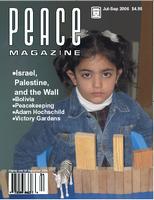
Peace Magazine Jul-Sep 2006, page 6. Some rights reserved.
Search for other articles by PMag staff here
"Aspiring sincerely to an international peace based on justice and order, the Japanese people forever renounce war as a sovereign right of the nation and the threat or use of force as means of settling international disputes.
"In order to accomplish the aim of the preceding paragraph, land, sea, and air forces, as well as other war potential, will never be maintained. The right of belligerency of the state will not be recognized."
The Constitution of Japan was established after World War II and was intended to replace the country's previous imperial system with liberal democracy. Written under supervision of General MacArthur and the occupation forces, the new document took into account the previous Meiji constitution, the demands of Japanese lawyers, and the opinions of pacifist political leaders, and came into effect in May 1947.
Article 9 is the unique provision within it whereby Japan renounces war and is prohibited from maintaining a military force. It was a clear promise by Japan to the world, and particularly Asia-Pacific region people, that the imperialistic aggressions of WWII would never be repeated. It kept a brake on Japan's arms build-up during the post-war era, which has provided a sense of security for the entire region.
It is the main reason why Japan has been able to sustain peace and stability, with the country having militarily taken no part in war in over half a century. It has inspired attempts at the resolution of international problems of disarmament and nuclear weapons abolition, for example at The Hague Peace Conference of 1999. It is a blueprint for how to save future generations from the scourge of war.
The previous century was the bloodiest of human history. It contained two world wars, three decades of arms-fueled tensions between the world's superpowers, and hundreds of genocidal purges, civil wars, armed invasions, military coups, revolutionary struggles, border disputes, and localized conflicts causing over 100 million deaths. As the new century gets underway, prospects for reversing this trend do not seem promising.
Article 9 has been under serious pressure since its inception. Even whilst Japan was still under US occupation, moves were made towards creating some sort of military organization. Thus the creation of what became the Japan Self Defense Forces (SDF), which has seen constant court battles between government and critics over its legitimacy. Extensions of Article 9's ethos, such as Japan's non-nuclear principles and ban on arms exports, face active opposition from those keen to remilitarize the country.
The US is encouraging Japan to abandon what it adopted after WWII. The Japanese military were dispatched to assist the US-led war in Afghanistan and used for refueling U.S. and British warships. In July 2003, Japan's parliament passed a law authorizing the use of Japan's SDF in Iraq, as long as they were confined to conducting humanitarian missions.
The removal of Article 9 would seriously affect the foreign policies of Asia's most powerful states. If Japan were to again become a military force, it would undoubtedly reinvigorate China's push for a powerful military. Russia could see a powerful Japan as a threat to its territory and interests in East Asia, and North Korea could feel backed even further into a corner. Memories of Japanese wartime aggression are still fresh even in South Korea, and the normalization of good relations still has far to go.
As the prospects rise of a future with more wars over ever dwindling energy supplies, a world of environmental refugees, nuclear proliferation across the planet and the unravelling of international law and order, it is vital to uphold the signposts toward a better future. Article 9 must be maintained and its principles spread.
This article was contributed by: Peace Not War Japan www.pnwj.org; Global Article 9 Campaign http://www.article-9.org; Article 9 Association www.9-jo.jp

Peace Magazine Jul-Sep 2006, page 6. Some rights reserved.
Search for other articles by PMag staff here